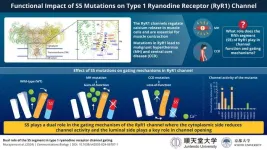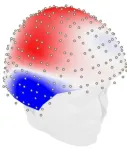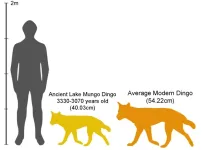Contact: Gina DiGravio, Boston University, 617-358-7838, ginad@bu.edu
Contact: Andrea Zeek, IU School of Medicine, 317-671-3114, anzeek@iu.edu
(Boston)— The failure to diagnose Alzheimer’s disease, the most common form of dementia in the elderly, at an early stage of molecular pathology is considered a major reason why treatments fail in clinical trials. Previous research to molecularly diagnose Alzheimer’s disease yielded "A/T/N" central biomarkers based on the measurements of proteins, β-amyloid (“A”) and tau (“T”), and "N" encompassing neurodegeneration. A/T/N can be measured in brain tissue, by in vivo brain imaging techniques, and by analysis of cerebrospinal fluid and plasma.
Alzheimer’s disease is thought to be triggered by combinations of genetic and environmental risk factors. Blood-based biomarkers such as plasma microRNAs (miRNAs)—molecules that regulate genome-environment interactions and control the expression of genes governing brain functions which deteriorate in Alzheimer’s—could offer advantages of cost-savings, accessibility and decreased invasiveness.
Two new papers by a team of researchers at Boston University, the Indiana University School of Medicine and the Alzheimer’s Disease Neuroimaging Initiative (ADNI), and the German Center for Neurodegenerative Diseases (DZNE) in Goettingen, Germany, published in Alzheimer’s & Dementia: The Journal of the Alzheimer's Association demonstrate that evaluating microRNAs in blood can be used not only to diagnose mild cognitive impairment (MCI) but also, critically, to predict the conversion from MCI to dementia due to Alzheimer’s disease. Moreover, the researchers uncovered microRNA candidate molecular biomarkers that associate with current Amyloid, Tau, and Neurodegeneration (A/T/N) Alzheimer’s biomarkers.
“Our papers are the result of a successful collaboration that tied the technology developed by professor Andre Fischer in Germany’s DZNE to reliably measure the levels of microRNA in human plasma, and the power of blood samples obtained from hundreds of ADNI participants participating in a simulated clinical trial taking place at about 60 medical centers across the US and Canada. Our discovery is important because, unlike the current A/T/N biomarkers, microRNAs may serve as blood molecular biomarkers years before Alzheimer’s disease manifests clinically, thus identifying the time window for effective prevention or early intervention to stop the progression of Alzheimer’s,” explained one of four senior authors Ivana Delalle, MD, PhD, professor of pathology & laboratory medicine at Boston University Chobanian & Avedisian School of Medicine.
The other senior authors are Andre Fischer, PhD, DZNE speaker and professor of epigenetics of neurodegenerative diseases at University Medical Center Goettingen, Germany; Kwangsik Nho, PhD, professor of radiology and imaging sciences at the IU School of Medicine; and Andrew J. Saykin, PsyD, Raymond C. Beeler Professor of Radiology and director of the Center for Neuroimaging and the Indiana Alzheimer’s Disease Research Center at the IU School of Medicine. The work was funded by the National Institutes of Health’s National Institute on Aging multisite project RF1AG078299. “MicroRNAs as Diagnostic and Prognostic Biomarker of Alzheimer’s Disease” that supports the teams of researchers in multiple institutions.
The researchers examined miRNA expression in the plasma samples of three diagnostic groups of participants—cognitively normal, mildly cognitively impaired and dementia due to Alzheimer’s disease patients. They found that, when combined with neuropsychological testing, plasma microRNAome evaluation helps predict which aging individuals concerned about cognitive decline will progress to develop Alzheimer’s.
“These findings provide a path toward a better understanding the molecular mechanisms driving plaques, tangles and atrophy, and may provide clues for the next generation of therapeutic targets,” Saykin said.
While these are exciting times with novel therapies for Alzheimer’s disease entering clinical care, the researchers note that those therapies only will work in a real-world setting if patients at risk are identified as early as possible.
“MicroRNAs are ideal biomarkers since they are not only very stable but also control entire molecular pathways thereby ensuring cellular homeostasis. As such one microRNA can simultaneously control many proteins belonging to a certain pathway,” Fischer said. “Therefore, the analysis of a few microRNAs can inform about complex pathological changes reflecting multiple pathways, such as neuroinflammation, metabolic changes, or synapse dysfunction. Thus, we need biomarkers that allow screening applicable in a point-of-care setting. Our studies are an important step in this direction.”
“We have laid the groundwork for further investigations into the role of microRNAs in Alzheimer’s disease pathogenesis,” Nho said. “We envision that once specific miRNA signatures are further confirmed, the analysis of blood miRNAs will be transferred to simple assay formats enabling the adoption of blood miRNAome analysis in clinical practice.”
The researchers said improved tools for the early detection of Alzheimer’s are indispensable for developing prevention and treatment strategies for the disease that is causing enormous suffering and burdens health care systems around the world.
These findings appear online in Alzheimer’s & Dementia.
https://alz-journals.onlinelibrary.wiley.com/doi/full/10.1002/alz.14157
https://alz-journals.onlinelibrary.wiley.com/doi/full/10.1002/alz.14230
About Boston University Chobanian & Avedisian School of Medicine
Originally established in 1848, the New England Female Medical College, became coed as Boston University School of Medicine in 1873. The school today is a leading academic medical center with an enrollment of more than 600 medical students and approximately 1,200 students pursuing Master's and PhD degrees. School of Medicine faculty attract more than $277 million in research awards annually, in Alzheimer’s disease, arthritis, cardiovascular disease, cancer, infectious diseases, pulmonary disease, amyloidosis, and dermatology, among other areas. The school’s 30 teaching affiliates include Boston Medical Center, Boston VA Healthcare System; St. Elizabeth’s Medical Center in Brighton, Mass.; Kaiser Permanente in northern California; and many others. For more information, please visit http://www.bumc.bu.edu/camed/.
About Deutsches Zentrum für Neurodegenerative Erkrankungen, DZNE (German Center for Neurodegenerative Diseases)
DZNE is a research institute for neurodegenerative diseases such as Alzheimer’s, Parkinson’s and ALS, which are associated with dementia, movement disorders and other serious health impairments. To date, there are no cures for these diseases, which represent an enormous burden for countless patients, their families and the healthcare system. DZNE is dedicated to the development and translation into practice of novel strategies for prevention, diagnosis, care and treatment. The institute comprises ten sites across Germany and collaborates with universities, university hospitals, research centers and other institutions in Germany and throughout the world. It is state-funded and a member of the Helmholtz Association and of the German Centers for Health Research. www.dzne.de/en
About the IU School of Medicine
The IU School of Medicine is the largest medical school in the U.S. and is annually ranked among the top medical schools in the nation by U.S. News & World Report. The school offers high-quality medical education, access to leading medical research and rich campus life in nine Indiana cities, including rural and urban locations consistently recognized for livability. According to the Blue Ridge Institute for Medical Research, the IU School of Medicine ranks No. 13 in 2023 National Institutes of Health funding among all public medical schools in the country.
Support for this project was provided by the Alzheimer's Disease Neuroimaging Initiative (National Institutes of Health Grant U01 AG024904) and ADNI DOD (Department of Defense award number W81XWH-12-2-0012). Additional support for data analysis was provided by NLM R01 LM012535, NIA R03 AG063250, NIA R01 AG19771, NIA P30 AG10133, NIA P30 AG072976, NIA R01 AG057739, NIA U01 AG024904, NLM R01 LM013463, R01 AG068193, T32 AG071444, U01 AG068057, NIGMS P50GM115318, NCATS UL1 TR001108, NIA K01 AG049050, NIA R01 AG061788, the Alzheimer's Association, the Indiana Clinical and Translational Science Institute, and the IU Health-IU School of Medicine Strategic Neuroscience Research Initiative. ADNI is funded by the National Institute on Aging, the National Institute of Biomedical Imaging and Bioengineering, and through generous contributions from the following: AbbVie, Alzheimer's Association; Alzheimer's Drug Discovery Foundation; Araclon Biotech; BioClinica, Inc.; Biogen; Bristol-Myers Squibb Company; CereSpir, Inc.; Cogstate; Eisai Inc.; Elan Pharmaceuticals, Inc.; Eli Lilly and Company; EuroImmun; F. Hoffmann-La Roche Ltd and its affiliated company Genentech, Inc.; Fujirebio; GE Healthcare; IXICO Ltd.;Janssen Alzheimer Immunotherapy Research & Development, LLC.; Johnson & Johnson Pharmaceutical Research & Development LLC.; Lumosity; Lundbeck; Merck & Co., Inc.;Meso Scale Diagnostics, LLC.; NeuroRx Research; Neurotrack Technologies; Novartis Pharmaceuticals Corporation; Pfizer Inc.; Piramal Imaging; Servier; Takeda Pharmaceutical Company; and Transition Therapeutics. The Canadian Institutes of Health Research is providing funds to support ADNI clinical sites in Canada. Private sector contributions are facilitated by the Foundation for the National Institutes of Health (www.fnih.org). The grantee organization is the Northern California Institute for Research and Education, and the study is coordinated by the Alzheimer's Therapeutic Research Institute at the University of Southern California. ADNI data are disseminated by the Laboratory for Neuro Imaging at the University of Southern California. This research was supported in part by Lilly Endowment, Inc., through its support for the Indiana University Pervasive Technology Institute.
This work was supported by NIH RF1AG078299 ( I Delalle, JK Blusztajn, A Fischer, A Saykin, K Nho, H Lin, AL DeStefano, A Krunic); NIH U19 AG024904, P30 AG072976 and U19 AG074879 provide funding for A Saykin (also supported by NIH P30 AG010133, R01 AG019771, R01 AG057739, R01 LM013463, R01 AG068193, T32 AG071444, U01 AG068057, U01 AG072177), K Nho (also supported by NIH U01AG072177 and U19 AG074879), S Lui, T Park, Y-N Huang Y-N, and SL Risacher; NIH RF1 AG057768, P30 AG013846, RF1 AG072654 (JK Blusztajn); NIH U01AG068221 (H Lin and AL DeStefano); NIH U01 AG058589, R01DK122503 (AL DeStefano); The DFG (Deutsche Forschungsgemeinschaft) priority program 1738, SFB1286 and GRK2824;The German Federal Ministry of Science and Education (BMBF) via the ERA-NET Neuron project EPINEURODEVO; The EU Joint Programme- Neurodegenerative Diseases (JPND) – EPI-3E; Germany’s Excellence Strategy - EXC 2067/1 390729940 (A Fischer, DM Krueger, T Pena, Pradhan R, S Burkhardt, R Schroeder, N Hempel); GoBIO project miRassay (16LW0055) by the German Federal Ministry of 1 Science and Education (F Sananbenesi, A Schutz).
Note to editor:
Dr. Saykin receives support from multiple NIH grants (P30 AG010133, P30 AG072976, R01 AG019771, R01 AG057739, U19 AG024904, R01 LM013463, R01 AG068193, T32 AG071444, U01 AG068057, U01 AG072177, and U19 AG074879). He has also received support from Avid Radiopharmaceuticals, a subsidiary of Eli Lilly (in kind contribution of PET tracer precursor) and participated in Scientific Advisory Boards (Bayer Oncology, Eisai, Novo Nordisk, and Siemens Medical Solutions USA, Inc) and an Observational Study Monitoring Board (MESA, NIH NHLBI), as well as External Advisory Committees for multiple NIA grants. He also serves as Editor-in-Chief of Brain Imaging and Behavior, a Springer-Nature Journal. Dr. Shannon Risacher served as Communications Chair, unpaid, for the Alzheimer's Association AWARE PIA, as well as received travel funding for the Charleston Conference on Alzheimer's Disease. She also has equity interest in Eli Lilly (a company that may potentially benefit in the research results of this study. Dr. Shiwei Liu, Dr. Thea Rosewood, Dr. Kwangsik Nho, Ms. Soumilee Chaudhuri, Ms. Min Young Cho, Dr. Yen-Ning Huang, Dr. Tamina Park have no interest to declare. The funders had no role in the study's design, the collection, analyses, or interpretation of data, the writing of the manuscript, or the decision to publish the results.
END





